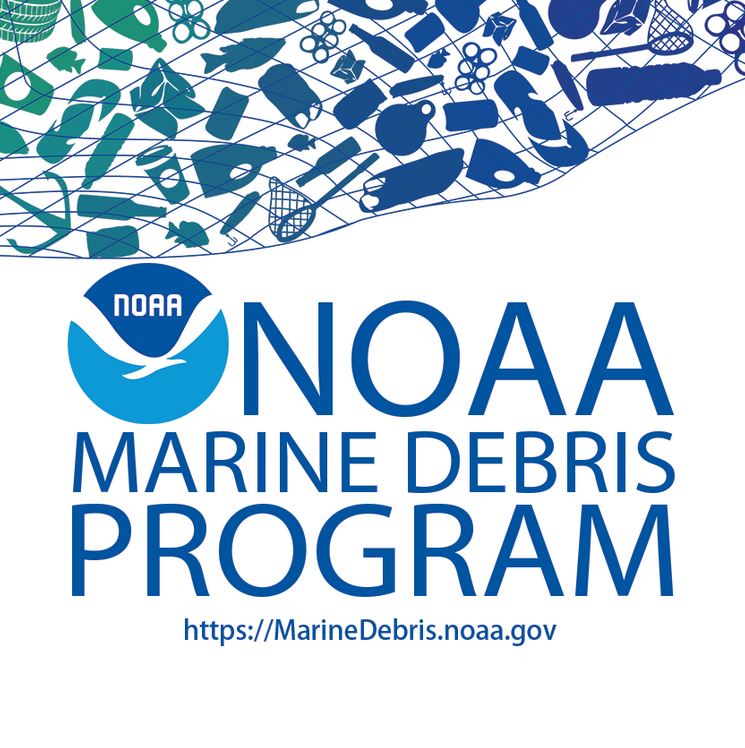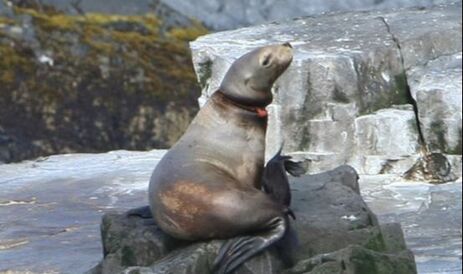Kodiak Archipelago Marine Debris Ingestion Prevention Through Habitat Restoration
ITN Mission Area: Develop and promote stewardship, restoration and maintenance projects for coastlines.
Project Dates: 2020-2021 Summary: ITN is using small and large vessels teams to clean continuous stretches of shoreline around the Kodiak archipelago, a proven and effective method of addressing the worst-affected areas. A grant from NOAA was the primary funding source for two expeditions in 2021 and enhanced a third expedition in 2020. Funding Partners: NOAA |
Entanglement With Marine Debris Kills Marine Mammals
In recent decades marine debris has become recognized as a pernicious threat to the marine environment and coastal communities of the Kodiak archipelago. Entanglement in and ingestion of marine debris impacts hundreds of marine species worldwide including marine mammals, and can have lethal and sub-lethal effects (CBD 2012). Physical contact with marine debris, particularly entanglements with net and line, is a significant cause of mortality of marine mammals, and poses a serious threat to the Gulf of Alaska ecosystem. Several of these marine mammal species are of important subsistence and cultural value to the Alutiiq people of Kodiak and other Alaska Natives.
|
Pinnipeds, in particular otariids, are known suffer severe injuries, and to die from marine debris in Alaska waters.In the Gulf of Alaska, the Alaska Department of Fish and Game (ADF&G) annually surveys Steller sea lions at haulouts and rookeries during the breeding season. From 2000-2017, ADF&G photo-documented approximately 360 live Steller sea lions with neck entanglements; the most common entangling materials were plastic packing bands, large rubber bands, and rope (Raum-Suryan et al. 2009 and L. Jemison, personal communications April 17, 2018). The Kodiak archipelago provides important year-round and breeding habitat for this endangered species. Steller sea lion critical habitat has been designated throughout nearly the entire Kodiak archipelago, and six traditional haulouts are near coastal areas identified for restoration under this proposal.
|
Studies have shown that northern fur seals have a propensity to become entangled in fragments of trawl netting and plastic packing bands. Over a ten year-period on St. Paul Island, about 0.4% of young male fur seals observed had been entangled in debris (Fowler 1987). The Kodiak archipelago is within the winter range of the northern fur seal. Harbor seals, the only phocids in the Gulf of Alaska, are abundant and widely distributed around the Kodiak archipelago (Pitcher 1990, Small et al. 2003). Although long-term observational studies of harbor seals have been conducted at the south end
of the Kodiak archipelago (e.g.,Daniel et al. 2003, Hastings et al. 2012) few harbor seals have been observed entangled in debris during these studies (L. Jemison, personal communications April 17, 2017). However, phocids in other regions have been seriously injured by entangling materials (Allen et al. 2012).
Cetaceans are also threatened by marine debris in Alaskan waters. A study of humpback whales in northern Southeast Alaska found that 71% of whales observed had unambiguous scars due to entanglements in fishing gear (Neilson, 2006). Hawaiian Island Humpback Whale National Marine Sanctuary biologist Ed Lyman reported that a minimum of 20 humpback whales have arrived in the sanctuary entangled in fishing gear believed to be from Alaska. Lyman also serves on the Alaska Disentanglement network and has firsthand experience removing derelict gear from whales, citing longline and pot gear as the most common to entangle a whale.Observed impacts to the whales included lacerations from contact with rope, and malnourishment and exhaustion due to the drag associated with the entangling material during swimming and diving. (E. Lyman, pers. Communications). Similarly, a 2016 study on bowhead whales in the Bering, Chukchi and Beaufort seas concluded that of 15 reports of bowhead entanglements, four were confirmed to be caused by commercial pot gear (George et al. 2017).
Critical habitat has been established for the critically endangered North Pacific right whale, just east of Kodiak in the Barnabas Trough. A 2013 Alaska Marine Mammal Stock Assessment explained that the habitat designation is based primarily on sonobuoy detections, as there are believed to be fewer than 26 North Pacific right whales remaining, and sightings in the Gulf of Alaska are exceptionally rare (Allen, and Angliss 2013).
Finally, sea otters are denizens of the nearshore, and are also threatened with entanglement in nearshore fisheries. A 2002 study of the salmon set gillnet fishery in Kodiak, conducted by NOAA Fisheries,documented 4 entanglements, resulting in a bycatch estimate of 62 animals. A continuation of the study in 2005 estimated bycatch at 28 animals (Manly 2007). Gillnet fisheries pose a threat to other marine mammals, and were responsible for an estimated 84% of cetacean and 98% of pinniped bycatch in U.S. fisheries from 1990 to 1999 (Read et al. 2006)
References Cited
Allen, B.M., and R.P. Angliss. North Pacific Right Whale; Eastern North Pacific Stock (Fact Sheet). Alaska Marine Mammal Stock Assessments, Revised 5/15/2013. (http://www.nmfs.noaa.gov/pr/sars/2013/ak2013_northpacificrightwhale.pdf)
Blight, Louise K. and A. E. Burger. Occurrence of Plastic Particles in Seabirds from the Eastern North Pacific. Marine Pollution Bulletin, Vol 34, No.5, pp 323-325, 1997.
CBD 2012.Impacts of Marine Debris on Biodiversity: Current Status and Potential Solutions. Secretariat of the Convention on Biological Diversity and the Scientific and Technical Advisory Panel, Montreal, Technical Series No. 67, 61 pages. (http://www.cbd.int/doc/publications/cbd-ts-67-en.pdf.)
Choy, C. Anela, J. Drazen. Plastic for dinner? Observations of frequent debris ingestion by pelagic predatory fishes from the central North Pacific. Marine Ecology Progress Series. Vol 485:155-163, 2013.
C.W. Fowler. 1987. Marine Debris and Northern Fur Seals: a Case Study. Marine Pollution Bulletin 18:326-335.
George, J.C., G. Sheffield, D.J. Reed, B. Tudor, R. Stimmelmayr, B.T. Person, T. Sformo, and R. Suydam. 2017. Frequency of Injuries from line Entanglements, Killer Whales, and Ship Strikes on Bering-Chukchis-Beaufort Seas Bowhead Whales. Arctic. 70:37-46.
Jambeck, J.R, R. Geyer, C. Wilcox, T.R. Siegler, M. Perryman, A. Andrady, R. Narayan, K.L. Law. Plastic waste inputs from land into the ocean. 2015. Science, Vol. 347- 6223: 768-771. http://science.sciencemag.org/content/347/6223/768
Jacobsen, J.K., L. Massey, F. Gulland. Fatal Ingestion of Floating Net Debris by Two Sperm Whales (Physeter macrocephalus). Marine Pollution Bulletin Volume 60, Issue 5, May 2010, Pages 765-767.
Jang, Mi., Won Joon Shim, Gi Myung Han, Manviri Rani, Young Kyoung Song, and Sang Hee Hong. Styrofoam Debris as a Source of Hazardous Additives for Marine Organisms Environ. Sci. Technol., 2016, 50 (10), pp 4951–4960. .
Manly, B.F.J. 2007. Incidental take and interactions of marine mammals and birds in the Kodiak Island salmon set gillnet fishery, 2002 and 2005. Western EcoSystems Technology Inc. Report. Cheyenne, Wyoming, USA. 221 pp.
Neilson, J.L., J.M. Straley, C.M. Gabriele, and S. hills. 2009. Non-lethal entanglement of humpback whales (Megapteranovaeangliae) in fishing gear in northern Southeast Alaska. Journal of Biogeography 36:452-464.
Raum-Suryan, K.L., L.A. Jemison, and G.W. Pitcher. 2009. Entanglement of Steller sea lions (Eumetopias jubatus) in marine debris: Identifying causes and finding solutions. Marine Pollution Bulletin 58:1487-1495.
Read, A.J., Drinker, P., and Northridge, S. 2006. Bycatch of marine mammals in U.S. and global fisheries. Conservation Biology 20(1):163 – 169.
Blight, Louise K. and A. E. Burger. Occurrence of Plastic Particles in Seabirds from the Eastern North Pacific. Marine Pollution Bulletin, Vol 34, No.5, pp 323-325, 1997.
CBD 2012.Impacts of Marine Debris on Biodiversity: Current Status and Potential Solutions. Secretariat of the Convention on Biological Diversity and the Scientific and Technical Advisory Panel, Montreal, Technical Series No. 67, 61 pages. (http://www.cbd.int/doc/publications/cbd-ts-67-en.pdf.)
Choy, C. Anela, J. Drazen. Plastic for dinner? Observations of frequent debris ingestion by pelagic predatory fishes from the central North Pacific. Marine Ecology Progress Series. Vol 485:155-163, 2013.
C.W. Fowler. 1987. Marine Debris and Northern Fur Seals: a Case Study. Marine Pollution Bulletin 18:326-335.
George, J.C., G. Sheffield, D.J. Reed, B. Tudor, R. Stimmelmayr, B.T. Person, T. Sformo, and R. Suydam. 2017. Frequency of Injuries from line Entanglements, Killer Whales, and Ship Strikes on Bering-Chukchis-Beaufort Seas Bowhead Whales. Arctic. 70:37-46.
Jambeck, J.R, R. Geyer, C. Wilcox, T.R. Siegler, M. Perryman, A. Andrady, R. Narayan, K.L. Law. Plastic waste inputs from land into the ocean. 2015. Science, Vol. 347- 6223: 768-771. http://science.sciencemag.org/content/347/6223/768
Jacobsen, J.K., L. Massey, F. Gulland. Fatal Ingestion of Floating Net Debris by Two Sperm Whales (Physeter macrocephalus). Marine Pollution Bulletin Volume 60, Issue 5, May 2010, Pages 765-767.
Jang, Mi., Won Joon Shim, Gi Myung Han, Manviri Rani, Young Kyoung Song, and Sang Hee Hong. Styrofoam Debris as a Source of Hazardous Additives for Marine Organisms Environ. Sci. Technol., 2016, 50 (10), pp 4951–4960. .
Manly, B.F.J. 2007. Incidental take and interactions of marine mammals and birds in the Kodiak Island salmon set gillnet fishery, 2002 and 2005. Western EcoSystems Technology Inc. Report. Cheyenne, Wyoming, USA. 221 pp.
Neilson, J.L., J.M. Straley, C.M. Gabriele, and S. hills. 2009. Non-lethal entanglement of humpback whales (Megapteranovaeangliae) in fishing gear in northern Southeast Alaska. Journal of Biogeography 36:452-464.
Raum-Suryan, K.L., L.A. Jemison, and G.W. Pitcher. 2009. Entanglement of Steller sea lions (Eumetopias jubatus) in marine debris: Identifying causes and finding solutions. Marine Pollution Bulletin 58:1487-1495.
Read, A.J., Drinker, P., and Northridge, S. 2006. Bycatch of marine mammals in U.S. and global fisheries. Conservation Biology 20(1):163 – 169.


